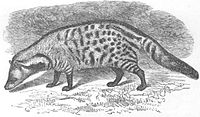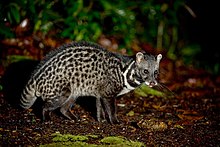விவேரா
| விவேரா புதைப்படிவ காலம்:Miocene–Present[1] | |
|---|---|

| |
| மாதிரி சிற்றினம், விவேரா சிபெத்தா | |
| உயிரியல் வகைப்பாடு | |
| திணை: | |
| பிரிவு: | |
| வகுப்பு: | |
| வரிசை: | |
| குடும்பம்: | விவெரிடே
|
| பேரினம்: | விவேரா லின்னேயஸ், 1758
|
| மாதிரி இனம் | |
| விவேரா சிப்பெதா | |
| சிற்றினம் | |
|
உரையினை காண்க | |
விவேரா (Viverra) என்பது ஒரு பாலூட்டி பேரினமாகும். விவேராவை கரோலஸ் லின்னேயஸ் 1758-ல் முதன்முதலில் பேரினமாகப் பரிந்துரைத்து விவரித்தார். இது இந்தியப் பெரிய புனுகுப்பூனை (வி. சிப்பெதா) உள்ளிட்ட பல சிற்றினங்களை உள்ளடக்கியது. இந்தப் பேரினம் விவிரிடே குடும்பத்தில் ஜான் எட்வர்ட் கிரே என்பவரால் 1821 துணைநிலையில் வைக்கப்பட்டது.[2]
சிறப்பியல்புகள்[தொகு]
விவேரா சிற்றினங்கள் மற்ற பேரினங்களிலிருந்து முன்னங்கால் அடிப்படையில் வேறுபடுத்தப்படுகின்றன. இந்த சிற்றினங்களின் முன்னங்காலின் மூன்றாவது மற்றும் நான்காவது கால் இலக்கங்கள் உள்ளிழுக்காமல் பாதுகாப்காக உறையின் மூலம் செயல்படுகிறது. கால் பட்டை முடியால் சூழப்பட்டுள்ளன. மேலும் நீண்ட மற்றும் குறுகிய தலையோட்டுடன் குறுகிய, கிட்டத்தட்ட இணையான, சுருங்கிய இடுப்புடன் காணப்படும்.
வாழும் சிற்றினங்கள்[தொகு]
| பெயர் | பரம்பல் | படம் |
|---|---|---|
| இந்திய பெரும் புனுகுப்பூனை (வி. சிபெத்தா) லின்னேயஸ், 1758 | கிழக்கு இமயமலையின் தெற்கு சரிவுகள் நேபாளம், பூட்டான் மற்றும் வடகிழக்கு இந்தியா முதல் தென்கிழக்காசியா வரை[3] | 
|
| மலேய புனுகுப்பூனை (விவேரா டாங்காலுன்கா) கிரே, 1832[4] | சுமாத்திரா, மேங்கா தீவு, போர்னியோ, ரியோ-லிங்கா, பிலிப்பீன்சு[5] | 
|
| மலபார் புனுகுப் பூனை (வி. சிவெடினா) பிளைத், 1862[6] | இந்தியாவின் மேற்குத் தொடர்ச்சி மலை[7] | |
| பெரிய புள்ளி புனுகுப்பூனை (வி. மெகாசுபிலா) பிளைத், 1862[6] | மியான்மர், தாய்லாந்து, மலேசியா, கம்போடியா, லாவோஸ், வியட்நாம், சீனா[8] | 
|
மேற்கோள்கள்[தொகு]
- ↑ "Viverra". Paleobiology Database.
{{cite web}}: CS1 maint: url-status (link) - ↑ Gray, J. E. (1821). "On the natural arrangement of vertebrose animals". London Medical Repository 15 (1): 296–310. https://archive.org/stream/londonmedicalre08unkngoog#page/n314/mode/1up.
- ↑ Timmins, R. J.; Duckworth, J. W.; Chutipong, W.; Ghimirey, Y.; Willcox, D. H. A.; Rahman, H.; Long, B.; Choudhury, A. (2016). "Viverra zibetha". IUCN Red List of Threatened Species 2016: e.T41709A45220429. https://www.iucnredlist.org/species/41709/45220429. பார்த்த நாள்: 29 October 2018.
- ↑ Gray, J. E. (1832). "On the family of Viverridae and its generic sub-divisions, with an enumeration of the species of several new ones". Proceedings of the Committee of Science and Correspondence of the Zoological Society of London 2: 63–68. https://books.google.com/books?id=ZOdJAAAAcAAJ&pg=PA63.
- ↑ Duckworth, J. W.; Mathai, J.; Wilting, A.; Holden, J.; Hearn, A.; Ross, J. (2016). "Viverra tangalunga". IUCN Red List of Threatened Species 2016: e.T41708A45220284. https://www.iucnredlist.org/species/41708/45220284. பார்த்த நாள்: 30 October 2018.
- ↑ 6.0 6.1 Blyth, E. (1862). "Report of Curator, Zoological Department, February 1862". The Journal of the Asiatic Society of Bengal 31 (3): 331–345. https://archive.org/details/journalofasiatic3118asia/page/331.
- ↑ Mudappa, D.; Helgen, K.; Nandini, R. (2016). "Viverra civettina". IUCN Red List of Threatened Species 2016: e.T23036A45202281. https://www.iucnredlist.org/species/23036/45202281. பார்த்த நாள்: 30 October 2018.
- ↑ Timmins, R.; Duckworth, J. W.; WWF-Malaysia; Roberton, S.; Gray, T. N. E.; Willcox, D. H. A.; Chutipong, W.; Long, B. (2016). "Viverra megaspila". IUCN Red List of Threatened Species 2016: e.T41707A45220097. https://www.iucnredlist.org/species/41707/45220097. பார்த்த நாள்: 30 October 2018.
